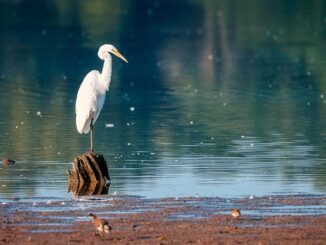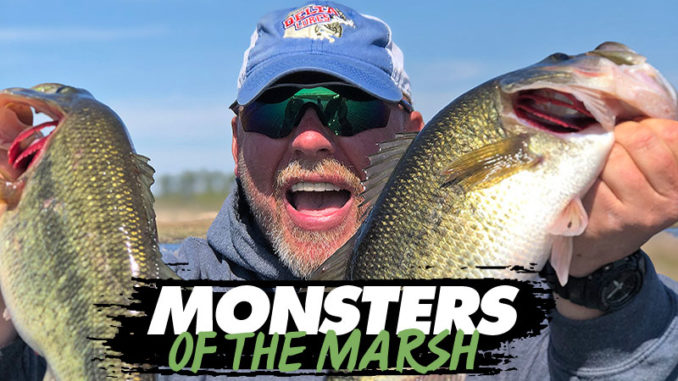
Bass are showing up, getting established and growing larger in areas where you would have found only redfish and trout a decade ago. Here’s how to target them.
It’s no secret that the marshes of southeast Louisiana have been going through change via freshwater diversions, storm surge and spillway openings.
The increase in freshwater has taken its toll on areas that were once labeled as saltwater fishing destinations. While this may have speckled trout and redfish anglers grumbling, bass fishermen are grinning from ear to ear.
Patrick Engerran of Ponchatoula finds himself venturing into the marsh to target bass more and more. Engerran is a tournament angler who primarily fishes on the Northshore of Lake Pontchartrain. With every year that passes, he finds himself running farther south to take advantage of bass that have taken up residence in what looks like speckled trout and redfish country.
“We’ve really seen the bass push farther south in the last couple of years, even into areas where you wouldn’t think they’d be,” he said.
Locally referred to as marsh bass, marsh pickles and tater chips, Engerran thinks they need a new name, because what was thought of as a nuisance fish or by-catch is making itself at home and thriving, turning into something worthy of attention.
“I think we need a new name for the marsh bass around here, because these things are monsters now,” he said. “Five years ago. there’s no way I’d be fishing the marsh for quality bass. The only way I’d be heading south was to fill out a limit, but now there are kickers in the marsh.”
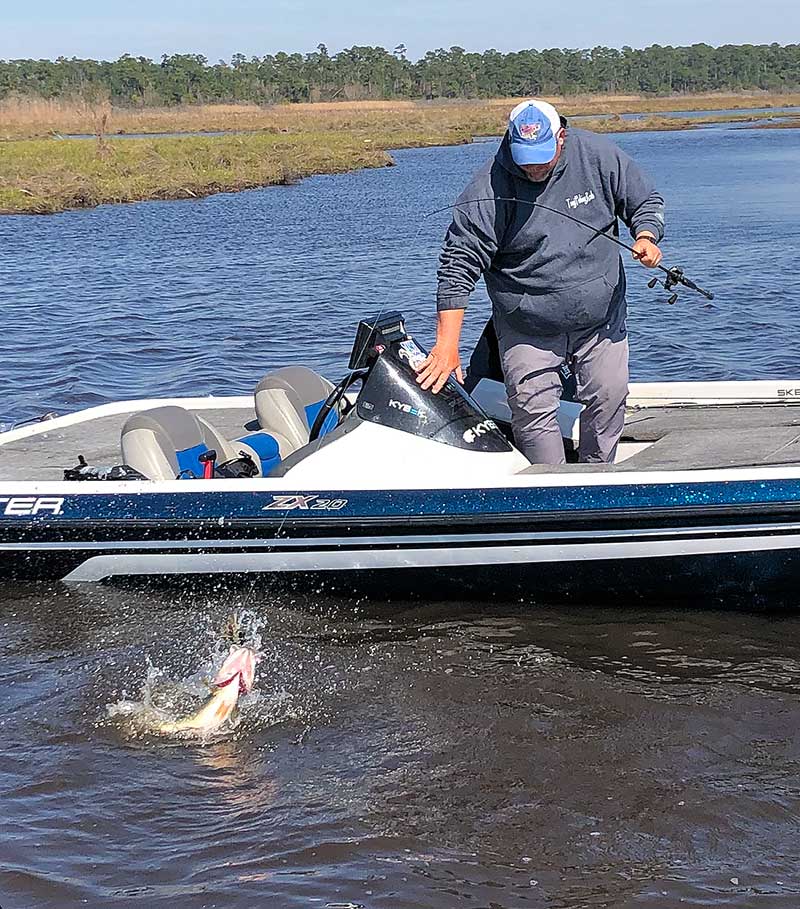
What’s a Marsh Bass?
In order to home in on what is happening to the marshes of southeast Louisiana, we need to take care of a common misconception folks have about marsh bass. We need to look at a study done in 1988 by biologists at the LSU School of Forestry, Wildlife and Fisheries. The study took bass from False River, which is freshwater, and from a brackish pipeline canal in Cut-Off that had a salinity level of two parts per thousand.
Biologists concluded that a marsh bass shares the same DNA as a typical, freshwater bass. The only difference is that the water they inhabit over time has an affect on their growth in numerous ways.
One test revealed that largemouth bass grow longer in freshwater than they do in brackish water. This explains why marsh bass are typically stockier than their freshwater relatives.
But what about the weight of these fish? After examining the stomachs of fish caught in brackish water, scientists concluded that the diet of a marsh bass is far superior to that of a freshwater bass. The stomach contents of marsh bass included grass shrimp, brown shrimp, cacohoes, pogies and shiners, compared to mostly invertebrates for the freshwater bass. This explains the girth and stomach size of marsh bass.
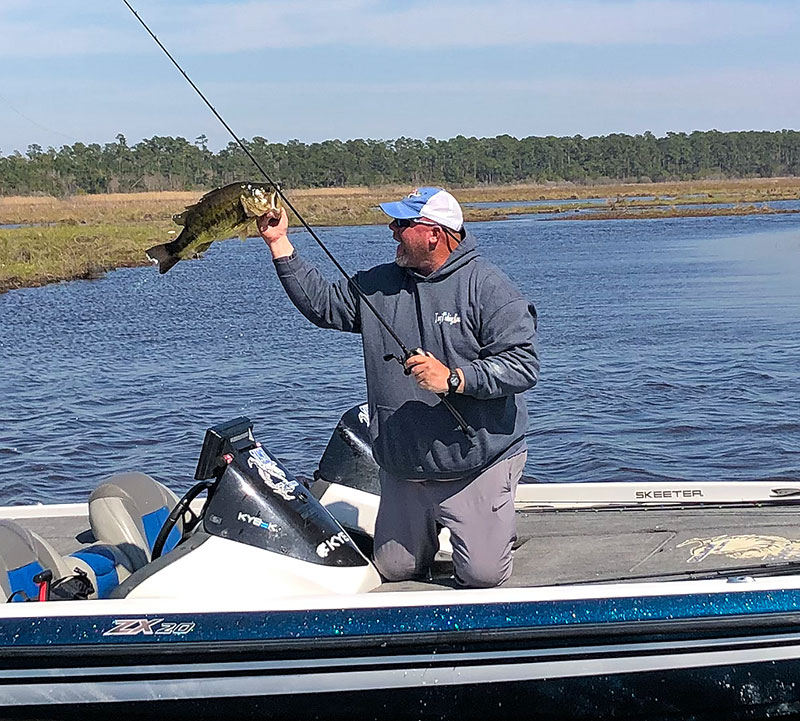
While marsh bass have the same DNA as a typical, freshwater largemouth bass, Engerran said they don’t act the same.
“These things are tanks,” he said. “There are some times when I think it’s a redfish slamming my spinnerbait because of how aggressive they are,
There are numerous theories about why marsh bass are more aggressive. One is that they have more competition for food; if they are slow to chase down bait, they might lose out to another, more aggressive fish like a redfish. Another is that, over time, the behavior of marsh bass starts to mimic surrounding fish that are more aggressive feeders. In any case, marsh bass are checking all the boxes for tournament anglers who are looking for heavy fish that hit just about anything thrown at them.
Lures and Technique
When fishing the marsh, it’s all about vegetation. The submerged grass, often a combination of eel grass and snot grass, can either form a mat on the surface when the tide is low or be completely submerged during high tide.
When the tide is low, Engerran uses a frog on the surface, but his favorite way to fish is running a fast-moving bait over the grass on a higher stage of the tide. He said swimbaits, vibrating jigs and buzzbaits work great over grass. For these baits, he uses braid with a graphite composite medium-heavy rod made by Tangi Rods.
“Marsh means grass, so I like a rod with a good backbone to get the fish’s head up quick, but a soft tip to let the fish suck in the fast-moving baits,” he said.
Another favorite tactic is to burn a spinnerbait over the vegetation, just under the surface. Engerran prefers a medium-heavy graphite rod and a reel spooled with monofilament.
“I’ve been known to set the hook a little fast when using a spinnerbait, so the mono helps delay the hookset because of how much it stretches,” he said.
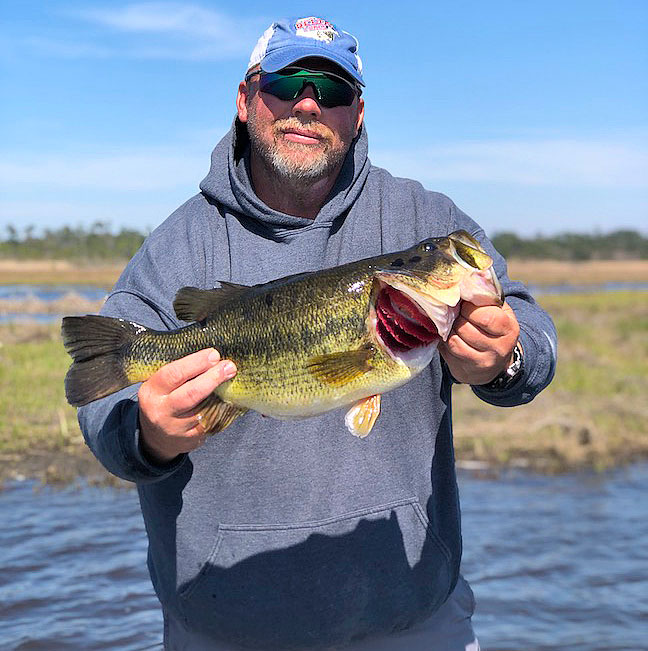
Personal-Best Marsh Bass
Engerran was pre-fishing for a tournament on one of his most-recent trips to the marsh. He was fishing Bayou Liberty in Slidell and headed south towards Lake Pontchartrain. As the brackish lake neared, the trees disappeared, and within seconds, the freshwater tributary transitioned into marsh, with mullet jumping, schools of pogies scattering across the surface and the calls of seagulls in the distance.
He dropped the trolling motor and started casting a white Z-Man ChatterBait with a green pumpkin crawfish trailer along a sun-soaked shoreline of marsh grass. One cast landed about a foot from the bank, and he started the retrieve, then saw a fish approach from beneath the surface.
“This fish pushed a wake that you dream about,” he said, “the kind of wake that leaves no doubt that he’s going to commit.”
Without hesitating, the fish caught up to the lure and inhaled it. For a few seconds Engerran thought it was a redfish.
“My first thought was, ‘Great I just ruined a new ChatterBait,’” said Engerran, whose sense of urgency rose as he saw a bass emerge from the water to throw the hook. He was able to get the fish close to the boat and lip it: the heaviest bass he’s ever caught in the marsh, a 6.89-pound chunk.
Engerran continued working through the marsh and was able to put together a 5-fish limit weighing more than 16 pounds.
“That was a deja vu moment for me,” he said. “It was that same stretch of grass where I caught a 5-pounder that won the Florida Parishes Bass Anglers tournament a few years ago.”
While Engerran fishes the marshes around Lake Pontchartrain, other anglers have reported catching bass upwards of 8 pounds, with three confirmed 10-pound bass caught in the ICW, Dike Canal and marsh along the northern section of Lake Borgne.
With no recent fish kills reported after Hurricane Ida, the momentum of the bass migration into the brackish marsh looks to continue for years to come. As long as that happens, Engerran said he’ll continue to venture into the marsh as long as these fish continue to grow.
“A 6-pound bass is a 6-pound bass no matter where you catch it,” he said.
